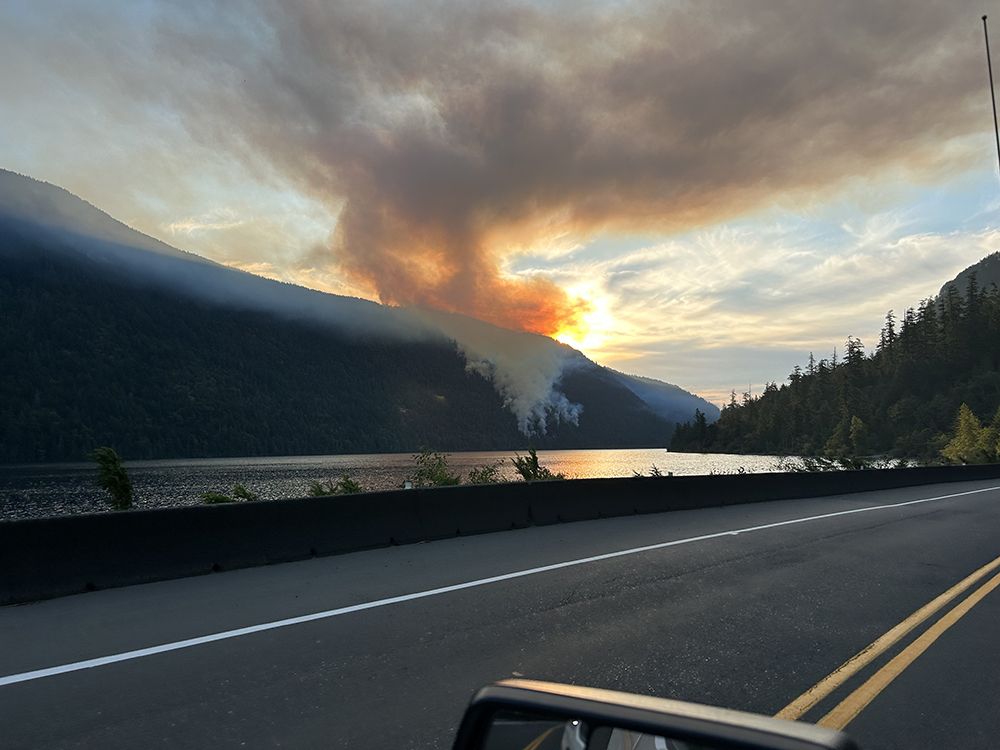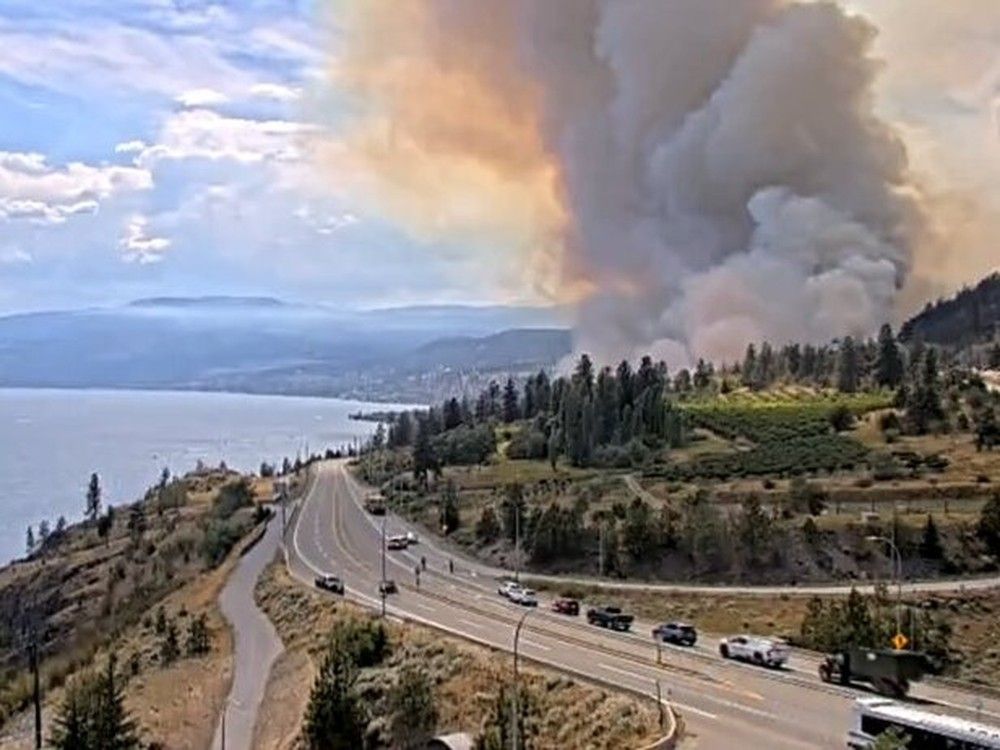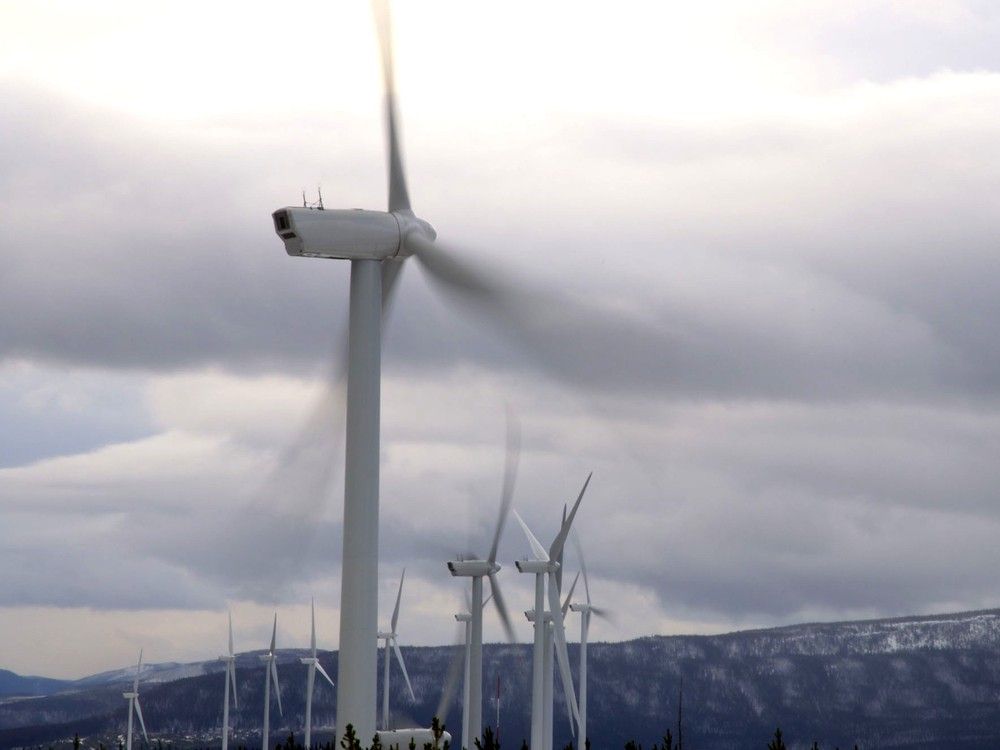
Here’s the latest news concerning climate change and biodiversity loss in B.C. and around the world, from the steps leaders are taking to address the problems, to all the up-to-date science.
Check back every Saturday for more climate and environmental news or sign up for our Climate Connected newsletter HERE.
In climate news this week:
• Crews battle 147 wildfires in B.C., with 41 new fires overnight Friday
• With fires burning across B.C., is it safe to continue with travel plans?
• Alberta heat wave brings added wildfire risk
• Trump administration cancels plans to develop new offshore wind projects
Human activities like burning fossil fuels and farming livestock are the main drivers of climate change, according to the UN’s intergovernmental panel on climate change. This causes heat-trapping greenhouse gas levels in Earth’s atmosphere, increasing the planet’s surface temperature.
The panel, which is made up of scientists from around the world, including researchers from B.C., has warned for decades that wildfires and severe weather, such as the province’s deadly heat dome and catastrophic flooding in 2021, would become more frequent and intense because of the climate emergency. It has issued a code red for humanity and warns the window to limit warming to 1.5 C above pre-industrial times is closing.
According to NASA climate scientists, human activities have raised the atmosphere’s carbon dioxide content by 50 per cent in less than 200 years, and “there is unequivocal evidence that Earth is warming at an unprecedented rate.”
As of July 14, carbon dioxide in the atmosphere was 429.61 ppm, slightly down from 430.51 ppm last month, according to NOAA data measured at the Mauna Loa Observatory, a global atmosphere monitoring lab in Hawaii. The NOAA notes there has been a steady rise in CO2 from under 320 ppm in 1960.

Climate change quick facts:
• The Earth is now about 1.3 C warmer than it was in the 1800s.
• 2024 was hottest year on record globally, beating the record in 2023.
• The global average temperature in 2023 reached 1.48 C higher than the pre-industrial average, according to the EU’s Copernicus Climate Change Service. In 2024, it breached the 1.5 C threshold at 1.55 C.
• The past 10 years (2015-2024) are the 10 warmest on record.
• Human activities have raised atmospheric concentrations of CO2 by nearly 49 per cent above pre-industrial levels starting in 1850.
• The world is not on track to meet the Paris Agreement target to keep global temperature from exceeding 1.5 C above pre-industrial levels, the upper limit to avoid the worst fallout from climate change including sea level rise, and more intense drought, heat waves and wildfires.
• On the current path of carbon dioxide emissions, the temperature could increase by as much 3.6 C this century, according to the IPCC.
• In June 2025, global concentrations of carbon dioxide exceeded 430 parts per million, a record high.
• Emissions must drop 7.6 per cent per year from 2020 to 2030 to keep temperatures from exceeding 1.5 C and 2.7 per cent per year to stay below 2 C.
• There is global scientific consensus that the climate is warming and that humans are the cause.
(Sources: United Nations IPCC, World Meteorological Organization, UNEP, NASA, climatedata.ca)
Latest News

Number of active wildfires in B.C. jumps to 147
Firefighters in B.C. are gearing up for a busy long weekend, as the number of active wildfires jumped to 120 Friday, up from 90 on Thursday.
Much of the province is parched from continuing hot and dry conditions. Although heat warnings have been lifted for parts of the B.C. Interior such as the Okanagan and Fraser Canyon, temperatures are still expected to be in the low-to-mid 30s, according to Environment and Climate Change Canada.
Heat warnings remained in effect Friday for Fort Nelson, and the North and South Peace regions. Lytton is under an air quality alert because of the wildfire smoke.
Meantime, The wildfire near Peachland that forced hundreds of residents to quickly evacuated their homes just days ago is no longer out of control and the evacuation order has been lifted for all residents.
On Vancouver Island, an evacuation order was issued for properties in the Nanaimo region including waterfront properties on the north side of Cameron Lake and a portion of Little Qualicum Falls Provincial Park.
The Wesley Ridge wildfire, which is burning on the north side of Cameron Lake, is considered out of control and has grown to 2.45 square kilometres from 0.2 sq. km. on Thursday.
The Nanaimo Regional District on Vancouver Island declared a state of local emergency because of the fire, about 60 kilometres from the City of Nanaimo.
Read more on the wildfire situation here.
—Tiffany Crawford, The Canadian Press
With fires burning across B.C., is it safe to continue with travel plans?
If there were a weekend that could be described as peak summer in B.C., this would be it. Local vacation destinations see a surge of visitors as the cities empty out a little.
But with forest fires raging across the province, is it advisable to travel?
“The August long weekend feels like the height of summer for us,” says Ellen Walker-Matthews, CEO of the Thompson Okanagan Tourism Association, where a wildfire is burning near Peachland. “We welcome people to continue with their plans.”
The patio at Bliss Bakery in Peachland was busy on Thursday, said owner Barry Yeo. Guests enjoyed baked goods and a water show as helicopters picked up buckets of water from the lake.
The bakery has a strong customer base, but business triples in the summer months, he said. “It should be business as usual this weekend,” he said.
Harrison Hot Springs is also open despite a wildfire burning about 20 kilometres away on the eastern shore of Harrison Lake.
“The village and the resort are very much open,” said Erinn Kredba, interim executive-director of Tourism Harrison River Valley. “This is a long weekend and businesses still need people to come.”
—Glenda Luymes
Alberta heat wave brings added wildfire risk
With Edmonton and most of north and central Alberta under heat warnings from Environment Canada, Alberta Wildfire officials enter the long weekend on pins and needles.
With daytime temperatures expected to exceed 30 C until a predicted break on Sunday, conditions are all too perfect for the ignition and spread of wildfire. And, it’s the long weekend, when many Albertans and visitors to this province will be pitching tents and gathering around campfires.
“The hot weather is driving up the fire danger in most of the province,” said Josee St-Onge, an information officer at Alberta Wildfire.
She said the only regions not under increased risk are parts of southern Alberta that have recently received a lot of rain, and the Rocky Mountain region.
Not only does the hot weather increase the risk of fires starting, it provides optimum conditions for existing blazes to spread. There are currently 53 wildfires burning in Alberta, 11 of them rated as “out of control.”
—Edmonton Journal
Trump administration cancels plans to develop new offshore wind projects
The Trump administration is cancelling plans to use large areas of federal waters for new offshore wind development, the latest step to suppress the industry in the United States.
More than 3.5 million acres had been designated wind energy areas, the offshore locations deemed most suitable for wind energy development. The Bureau of Ocean Energy Management is now rescinding all designated wind energy areas in federal waters, announcing on Wednesday an end to setting aside large areas for “speculative wind development.”
Offshore wind lease sales were anticipated off the coasts of Texas, Louisiana, Maine, New York, California and Oregon, as well as in the central Atlantic. The Biden administration last year had announced a five-year schedule to lease federal offshore tracts for wind energy production.
Trump began reversing the country’s energy policies after taking office in January. A series of executive orders took aim at increasing oil, gas and coal production.
The Republican president has been hostile to renewable energy, particularly offshore wind. One early executive order temporarily halted offshore wind lease sales in federal waters and paused the issuance of approvals, permits and loans for all wind projects. In trying to make a case against wind energy, he has relied on false and misleading claims about the use of wind power in the U.S. and around the world.
—The Associated Press

How Trump-vetted scientists are trying to shred the climate consensus
A new report from the U.S. Department of Energy says projections of future global warming are exaggerated, while benefits from higher levels of carbon dioxide such as more productive farms are overlooked. It concludes, at odds with the scientific mainstream, that policies to reduce greenhouse gas emissions risk doing more harm than good.
Released Tuesday, the report is part of an effort by the Trump administration to try to end the U.S. government’s authority to regulate greenhouse gases. It’s the output of scientists known for contradicting the consensus embodied in volumes of research by the Intergovernmental Panel on Climate Change, whose work is approved by virtually every nation.
Publishing an alternate approach to the science of global warming on the same day that the Environmental Protection Agency said it plans to revoke the endangerment finding — a determination that greenhouse gases harm public health and welfare — marks a step up in the administration’s war on regulations. Since its adoption in 2009, the endangerment finding has become the bedrock of many US environmental rules.
Climate experts say it will hobble the country’s efforts to rein in rising temperatures and lessen the impacts, such as more intense storms, droughts and wildfires. The federal government’s own research shows climate-fuelled extreme weather is already causing $150 billion in losses a year in the U.S.
—Bloomberg News
City of Ottawa four years behind in releasing greenhouse gas emissions reports
The City of Ottawa is four years behind in releasing greenhouse gas emissions reports and environment groups are left wondering just how much fossil fuels the city burns.
Usually, the city releases public reports tracking the amount of greenhouse gas emissions produced within Ottawa, but the last report was released for the 2020 emissions inventory findings.
That 2020 report said community emissions had decreased 15 per cent since 2012, but a further reduction of five to six per cent would be needed to meet Ottawa’s climate targets in the next five to 10 years.
Angela Keller-Herzog, executive director of the local environmental activist group CAFES Ottawa, says the city has a commitment to make those reports to the public.
“It’s really important for countries and cities to be tracking their greenhouse gas emissions,” she said. “If we’re going to do something about the problem, we need to figure out where our emissions are coming from. “Unfortunately, in the last few years, the city has been somewhat neglectful.”
—Ottawa Citizen
High in India’s Himalayan mountains, yak herders struggle to survive a warming world
Carrying her one-year-old son on her back, Tsering Dolma herds a dozen yaks into a stonewalled corral as evening approaches in the desolate mountains of India’s remote Ladakh region.
A few herders tending livestock are the only people visible for miles on the windswept plains where patchy grass gives way to gravelly foothills and stony peaks. For generations, herders such as Dolma have relied on snowmelt that trickled down the mountain folds to sustain the high-altitude pastures where their herds graze. But now, herders say, the snow and rain are less predictable, and there is less grass for yaks to eat.
“Earlier, it used to snow and rain, but now it has reduced a lot,” the 32-year-old says. “Even the winters are getting warmer than before.”
Much of the herding, milking and gathering of wool is done by women in Ladakh, an area near Tibet that was part of the ancient Silk Route. It’s work mostly done by hand.
In another valley, Kunzias Dolma is busy making tea with yak milk and checking her yak butter, while spinning her Buddhist prayer wheel with her right hand. The 73-year-old, who’s not related to Tsering Dolma, has spent her life around yaks, working long hours to make products from their milk and sewing blankets from their wool.
But that way of life is threatened as climate change makes Ladakh less hospitable to yaks and many in the younger generation seek other jobs.
—The Associated Press